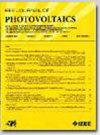In Situ MOVPE Smoothing of Acoustically Spalled GaAs for Substrate Reuse
IF 2.6
3区 工程技术
Q3 ENERGY & FUELS
引用次数: 0
Abstract
High material costs, especially for substrates, have limited the widespread adoption of III–V photovoltaics. A potential to reduce this cost is to reuse the III–V substrate via acoustic spalling, however this technique can leave a rough surface, hindering subsequent device performance. This research investigates the potential of using metalorganic vapor-phase epitaxy growth as a buffer layer to smooth the surface of acoustically spalled germanium and gallium arsenide (GaAs) substrates for improved III–V photovoltaic cell yield and performance, while retaining the maximum number of reuses of a substrate. Three potential smoothing layers were explored: lightly doped C:GaAs, highly doped Se:GaInP, and lightly doped Se:GaInP. C:GaAs showed the most promise as a smoothing layer, while Se:GaInP tended to conform to the underlying morphology, potentially increasing roughness in some areas. Utilizing 5声剥落GaAs衬底再利用的原位MOVPE平滑
高材料成本,特别是基板成本,限制了III-V型光伏电池的广泛采用。降低成本的一个潜力是通过声学剥落重新使用III-V基板,然而这种技术可能会留下粗糙的表面,阻碍后续设备的性能。本研究探讨了使用金属有机气相外延生长作为缓冲层的潜力,以光滑声剥落的锗和砷化镓(GaAs)衬底的表面,以提高III-V光伏电池的产量和性能,同时保留衬底的最大重复使用次数。探索了三种潜在的平滑层:轻掺杂C:GaAs,高掺杂Se:GaInP和轻掺杂Se:GaInP。C:GaAs作为光滑层最有希望,而Se:GaInP倾向于符合底层形貌,可能会增加某些区域的粗糙度。使用5美元\mu$m的C:GaAs作为平坦化缓冲,将平均效率(无增透涂层)从剥落基线从2.1%提高到4.9%,并且在使用5美元\mu$m的C:GaAs作为平坦化缓冲之前,进行5分钟30美元$ {\circ}$C 8:1:1 $\mathrm{H_{2}SO_{4}:H_{2}O_{2}:H_{2}O}$蚀刻,进一步将效率提高到11.1%。
本文章由计算机程序翻译,如有差异,请以英文原文为准。
求助全文
约1分钟内获得全文
求助全文
来源期刊

IEEE Journal of Photovoltaics
ENERGY & FUELS-MATERIALS SCIENCE, MULTIDISCIPLINARY
CiteScore
7.00
自引率
10.00%
发文量
206
期刊介绍:
The IEEE Journal of Photovoltaics is a peer-reviewed, archival publication reporting original and significant research results that advance the field of photovoltaics (PV). The PV field is diverse in its science base ranging from semiconductor and PV device physics to optics and the materials sciences. The journal publishes articles that connect this science base to PV science and technology. The intent is to publish original research results that are of primary interest to the photovoltaic specialist. The scope of the IEEE J. Photovoltaics incorporates: fundamentals and new concepts of PV conversion, including those based on nanostructured materials, low-dimensional physics, multiple charge generation, up/down converters, thermophotovoltaics, hot-carrier effects, plasmonics, metamorphic materials, luminescent concentrators, and rectennas; Si-based PV, including new cell designs, crystalline and non-crystalline Si, passivation, characterization and Si crystal growth; polycrystalline, amorphous and crystalline thin-film solar cell materials, including PV structures and solar cells based on II-VI, chalcopyrite, Si and other thin film absorbers; III-V PV materials, heterostructures, multijunction devices and concentrator PV; optics for light trapping, reflection control and concentration; organic PV including polymer, hybrid and dye sensitized solar cells; space PV including cell materials and PV devices, defects and reliability, environmental effects and protective materials; PV modeling and characterization methods; and other aspects of PV, including modules, power conditioning, inverters, balance-of-systems components, monitoring, analyses and simulations, and supporting PV module standards and measurements. Tutorial and review papers on these subjects are also published and occasionally special issues are published to treat particular areas in more depth and breadth.
 求助内容:
求助内容: 应助结果提醒方式:
应助结果提醒方式:


